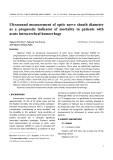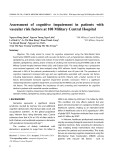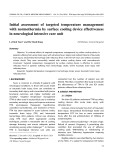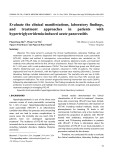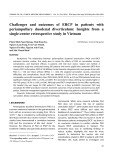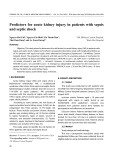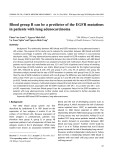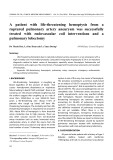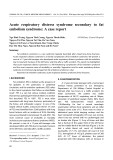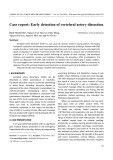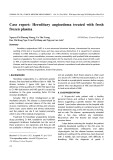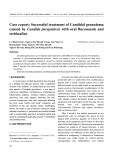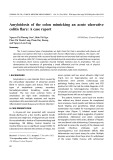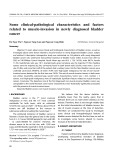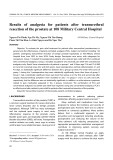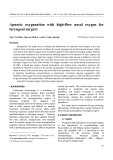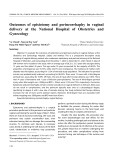
HUE JOURNAL OF MEDICINE AND PHARMACY ISSN 3030-4318; eISSN: 3030-4326HUE JOURNAL OF MEDICINE AND PHARMACY ISSN 3030-4318; eISSN: 3030-4326
114 115
Hue Journal of Medicine and Pharmacy, Volume 15, No.2/2025 Hue Journal of Medicine and Pharmacy, Volume 15, No.2/2025
A survey on antibiotic resistance of Extended-Spectrum beta-
lactamase-producing Escherichia coli isolated from urinary tract
specimens at Hue University of Medicine and Pharmacy Hospital
Le Thi Bao Chi*, Nguyen Duc Hoang Sang1, Ung Thi Thuy1, Nguyen Thi Khanh Linh1
Department of Microbiology, Hue University of Medicine and Pharmacy, Hue University
Abstract
Background: Urinary tract infections caused by Extended-Spectrum β-lactamase (ESBL)-producing
Escherichia coli (E. coli) strains are a major concern and a key driver of β-lactam antibiotic group’s resistance.
Finding the frequency of ESBL-producing E. coli isolated from urine samples and analyzing their antibiotic
resistance profiles were the objectives of this study. Materials and methods: A retrospective, cross-sectional
study was conducted on urine samples at Hue University of Medicine and Pharmacy Hospital from January
2023 to April 2024. Bacterial culture, identification, and antibiotic susceptibility testing were performed
according to standard microbiology laboratory procedures. Results: 104 ESBL-producing E. coli strains
were isolated, accounting for 45.2% of patients with urinary tract infections caused by E. coli. This group
was most common in patients over 60 years old, primarily from patients of the Urology outpatient clinic
and the Department of General Internal Medicine - Endocrinology - Musculoskeletal and the prevalence
was quite similar between males and females (46.9% and 44.6% respectively). The isolates showed high
resistance to ampicillin, some cephalosporins, and quinolones, but still remained highly susceptible (>90%)
to carbapenems and fosfomycin, and fully susceptible to nitrofurantoin. Conclusion: E. coli producing ESBL
are a real burden in the treatment of urinary tract infections. Consequently, investigating the antibiotic
resistance profiles of ESBL-producing E. coli in clinical settings is essential for informing physicians’ decisions
on appropriate antimicrobial therapy.
Keywords: urinary tract infections, E. coli, ESBL, antibiotic resistance.
*Corresponding Author: Le Thi Bao Chi; Email: ltbchi@huemed-univ.edu.vn
Received: 21/1/2025; Accepted: 10/4/2025; Published: 28/4/2025
DOI: 10.34071/jmp.2025.2.17
1. INTRODUCTION
Urinary tract infections (UTIs) are among the
most common bacterial infections. This infection
affects 150 million people worldwide annually
and can especially cause recurrent infections in
perimenopausal and menopausal women. The most
common cause of UTIs is Gram-negative bacteria
belonging to the Enterobacteriaceae family. Some
common members of this family include Escherichia
coli (E. coli), Klebsiella, Enterobacter, and Proteus.
Moreover, the emergence of Gram-negative bacteria
capable of producing extended-spectrum beta-
lactamases (ESBLs) has contributed to the growing
epidemiological concern of antibiotic resistance
among enteric pathogens. This issue primarily arises
from the ability of these bacteria to produce enzymes
that hydrolyze and render ineffective a broad range
of beta-lactam antibiotics, including third- and
fourth-generation cephalosporins, penicillins, and
aztreonam.The high antibiotic resistance associated
with beta-lactams in Uropathogenic Escherichia
coli (UPEC) strains, related to ESBL production,
significantly reduces treatment effectiveness, limits
treatment options, increases treatment costs, and
raises mortality rates in the clinical management of
UTIs [1].
There are several studies worldwide on ESBL-
producing UPEC strains from various types of
specimens, including urine. Shayan et al. (2015)
reported that up to 62.7% of E. coli strains carried
ESBLs with the presence of CIT, FOX, and TEM
encoding genes [2]. Similar results were also
reported from studies by Pootong et al. (2018) in
a hospital in Central Thailand and by Sadeghi et
al. (2021) in Iran, with ESBL-carrying E. coli rates
of 38.7% and 46%, respectively [3, 4]. Recent data
recorded in 2022 by Radera et al. studying the
virulence genotype and multidrug resistance of E.
coli isolated from community-acquired and hospital-
acquired UTIs, showed that hospital-acquired E.
coli strains were more resistant to more drugs than
community-acquired strains, including carbapenem
and ceftazidime [5]. Many other studies have also
reported similar results on ESBL-producing Gram-
negative bacilli or Enterobacterales [6, 7].
In Vietnam, the detection of ESBL-producing E.






